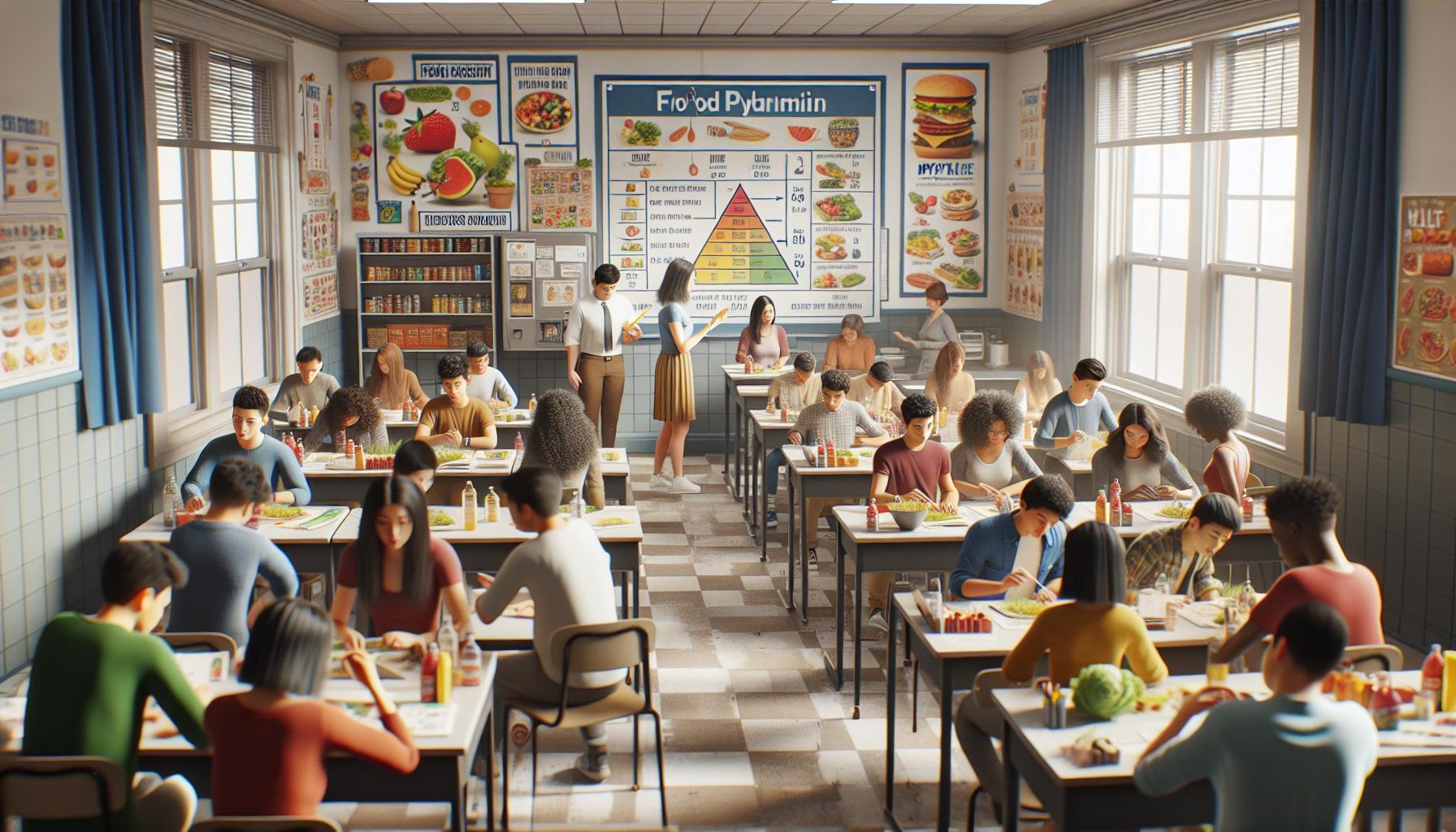Key Takeaways
- Empowers Healthy Choices: Nutrition and wellness classes equip high school students with essential knowledge, fostering healthier lifestyle choices that can last a lifetime.
- Focus on Nutritional Education: The curriculum covers vital topics such as macronutrients, dietary guidelines, and food labeling, enabling students to make informed dietary decisions.
- Integration of Physical Activity: The significance of physical activity is emphasized, linking exercise with mental well-being and encouraging students to adopt active lifestyles.
- Interactive Learning Approaches: Engaging teaching methodologies like cooking demonstrations, group discussions, and practical applications enhance student participation and retention of knowledge.
- Benefits for Mental Health: Nutrition education positively influences students’ mental well-being by helping them understand the connection between diet, mood, and cognitive function.
- Addressing Challenges: Implementation faces hurdles like limited resources and diverse student needs, highlighting the importance of adaptability and support in delivering effective nutrition education.
In today’s fast-paced world, understanding nutrition and wellness is more crucial than ever, especially for high school students. A dedicated class on these topics equips young individuals with the knowledge and skills to make healthier choices, fostering lifelong habits that promote well-being. As they navigate the complexities of adolescence, students face numerous challenges related to diet, mental health, and physical activity.
This class serves as a vital resource, empowering students to explore the connection between food, mood, and overall health. With engaging lessons and practical applications, they learn to critically assess their dietary habits and develop strategies for a balanced lifestyle. By prioritizing nutrition and wellness education, schools can help shape a generation that values health and well-being, setting the stage for a brighter future.
Nutrition And Wellness High School Class
Nutrition and wellness classes provide essential education for high school students, equipping them with knowledge that fosters healthier lifestyle choices. These courses address vital aspects of well-being, creating a foundation for lifelong health.
Importance of Nutrition Education
Nutrition education plays a crucial role in shaping students’ understanding of food and its impact on health. Students learn about essential nutrients, dietary guidelines, and food labeling. This knowledge helps them make informed decisions about their diets, promoting healthier eating habits. Understanding the relationship between nutrition and physical health enhances their ability to maintain a balanced lifestyle and manage weight effectively. Additionally, knowledge of nutrition supports mental well-being, as students discover how dietary choices influence mood and cognitive function.
Goals of the Curriculum
The curriculum aims to achieve several key objectives. First, it promotes awareness of nutritional concepts such as macronutrients and micronutrients. Second, it encourages the development of meal planning skills, teaching students to prepare healthy meals from diverse food groups. Third, it focuses on building critical thinking skills regarding food marketing and its effects on appetite and choices. Lastly, it emphasizes the importance of physical activity as a component of overall wellness, helping students understand the synergy between diet and exercise. The combined goals enhance students’ ability to lead healthy, fulfilling lives.
Key Components of the Class

Nutrition and wellness classes incorporate critical elements to equip students with the tools needed for healthy living. The curriculum integrates essential guidelines and practices aimed at cultivating informed lifestyles.
Nutritional Guidelines and Food Choices
Nutritional guidelines inform students about essential nutrients, such as carbohydrates, proteins, fats, vitamins, and minerals. They learn about the Dietary Guidelines for Americans, which emphasize nutrient-dense food selections like fruits, vegetables, whole grains, and lean proteins. Students engage with the Food Pyramid or MyPlate models to understand portion sizes and the balance of food groups.
Students evaluate food labels to discern serving sizes, ingredient lists, and nutritional content. Activities that incorporate analyzing fast food options or packaged goods help students identify healthier choices in everyday situations. Additionally, they explore topics such as meal planning, budgeting, and the significance of hydration, fostering habits that lead to a well-rounded diet.
Physical Activity and Health
Physical activity’s role in overall health is a central focus of the course. Students examine the relationship between exercise and mental well-being, recognizing that regular physical activity reduces stress and anxiety. The curriculum covers the recommended 150 minutes of moderate-intensity exercise per week for adolescents and its benefits on cardiovascular health, flexibility, and strength.
Students participate in discussions and activities that promote active lifestyles, such as setting fitness goals and tracking their progress. They explore various types of exercise, including aerobic, strength training, and recreational activities. Understanding the importance of movement solidifies the link between physical health and nutrition, encouraging students to adopt habits that support a balanced, healthy life.
Teaching Methodologies

Teaching methodologies in a nutrition and wellness high school class focus on engaging students through various practices. These approaches enhance understanding and retention of essential concepts related to nutrition and wellness.
Interactive Learning Techniques
Interactive learning techniques foster active participation and collaboration among students. Group discussions encourage students to share experiences related to food choices and lifestyles. Hands-on activities, such as cooking demonstrations, allow students to apply their knowledge by preparing healthy meals, emphasizing nutrition’s practical aspects. Technology integration, including nutrition apps and online resources, supports research and personal tracking of dietary habits. Role-playing scenarios help students navigate real-life situations, such as grocery shopping and meal planning, building confidence in making informed choices.
Practical Applications in Daily Life
Practical applications bridge classroom learning and real-world experiences. Classes incorporate projects where students create meal plans tailored to individual needs and preferences. Students may conduct food journals, documenting daily intake to assess nutritional balance and identify areas for improvement. Wellness challenges promote physical activity, encouraging participation in community events or personal fitness goals. Workshops on label reading and portion control empower students to make healthier choices when shopping. These applications reinforce the importance of nutrition and wellness in their daily lives, equipping students with skills for lifelong health management.
Benefits for Students

Nutrition and wellness classes offer high school students numerous advantages that extend beyond the classroom. These benefits include improved eating habits and enhanced mental well-being, both crucial for overall health.
Improved Eating Habits
Nutrition education cultivates healthier dietary choices among students. Students learn about essential nutrients and their roles in the body, leading to increased awareness of food selection. They gain practical skills in meal planning and understanding food labels, enabling informed decisions at the grocery store. Engaging activities such as cooking demonstrations and interactive lessons reinforce these concepts, promoting an understanding of balanced meals and portion sizes. Research indicates that students who receive nutrition education typically show a preference for fruits, vegetables, and whole grains over processed foods. This shift helps them adopt long-term healthy eating patterns that establish a foundation for lifelong wellness.
Enhanced Mental Well-being
Nutrition classes significantly impact students’ mental health. Understanding the link between food and mood empowers students to make choices that support emotional well-being. Lessons on the benefits of specific nutrients, such as omega-3 fatty acids and antioxidants, promote cognitive functioning and stress management. Regular assessments, such as food journals, encourage self-reflection on dietary habits and their effects on mood, enhancing mindfulness. Moreover, practical applications, like wellness challenges, foster a sense of community and support among peers. Evidence suggests that students engaged in nutrition education report lower levels of anxiety and depression, contributing to a more positive school experience.
Challenges in Implementation
Implementing nutrition and wellness classes in high schools presents various challenges, including limited resources and diverse student needs.
Limited Resources and Funding
Limited resources and funding significantly hinder the establishment and maintenance of nutrition and wellness classes. Schools often struggle with budgeting constraints that affect the availability of necessary materials, equipment, and facilities for practical lessons. Lack of funding restricts access to professional development opportunities for teachers, impacting their ability to deliver engaging and up-to-date content effectively. Additionally, financial limitations may prevent schools from incorporating essential components such as cooking demonstrations and interactive workshops, which enhance student learning experiences. These challenges highlight the need for improved financial support to ensure the successful implementation of comprehensive nutrition education programs.
Diverse Student Needs
Diverse student needs create complexities in delivering nutrition and wellness classes. Students come from various cultural, socioeconomic, and dietary backgrounds, making it crucial for the curriculum to reflect these differences. Tailoring lessons to accommodate individual preferences and challenges proves challenging for educators. For instance, specific dietary restrictions or cultural food practices may require alternative lesson plans or activities to ensure inclusivity. Additionally, varying levels of prior knowledge and interest in nutrition can create disparities in student engagement. Adapting teaching strategies and materials to meet these diverse needs enhances participation and learning outcomes, emphasizing the importance of a flexible and responsive curriculum in nutrition education.
Nutrition And Wellness Education
Nutrition and wellness education is vital for high school students as it lays the groundwork for healthier lifestyles. By equipping them with essential knowledge and practical skills, these classes encourage informed dietary choices and promote mental well-being. The interactive approach fosters engagement and helps students connect classroom lessons to real-life applications.
Overcoming challenges in implementing these programs is crucial for maximizing their impact. With adequate resources and tailored teaching strategies, schools can create an inclusive environment that addresses diverse student needs. Prioritizing nutrition and wellness education not only benefits individual students but also contributes to a healthier future generation. Investing in this education is an investment in lifelong health and well-being.
